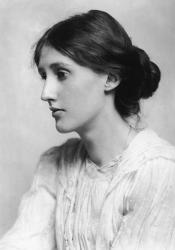"Orlando: A Biography" by Virginia Woolf
Virginia Woolf was one of the major literary figures in the twentieth century. She was a “prominent member of the avant-garde, intellectual Bloomsbury Circle in northern London from the years directly preceding World War I until her suicide in 1941” (Cersonsky). Her father was Leslie Stephen, a well-known editor of the first Dictionary of National Biography, and a pronounced atheist and overbearing patriarch. Her mother was Julia Prinsep Jackson and was loving and giving to Virginia and her other siblings. All throughout her childhood, Woolf was well-supported and educated until her adolescence. Her mother passed away when Virginia was 13 as well as her older sister Stella, her father, and her idolized brother Toby over the following decade. This traumatic experience forced Woolf’s mental health to go into a downward spiral. She began to have multiple mental breakdowns leaving her debilitated for months, confined to bed, and given barbiturates to curb suicidal impulses. “According to the psychiatry of her day, Woolf’s depression and hallucination were diagnosed as “neurasthenic,” for which doctors prescribed large amounts of rest and prohibited exercise or mental exertions such as reading and writing. There is no consensus as to Woolf’s actual mental illness, but many now believe it to have been some form of bipolar disorder” (Cersonsky). She soon married another writer, Leanord Woolf in 1912 and he became Virginia’s lifeline for her mental health. He even was supportive when she voiced her later attraction to women and affairs with them. She later continued to struggle with her mental illness and after writing her beloved novels, she drowns herself in the Ouse River on March 28, 1941.
In Woolf’s novel Orlando: A Biography, the protagonist, Orlando, a writer who lives from Elizabethan times to the present (1928), encounters various famous figures, and transitions from a man to a woman halfway through the novel. “Woolf dedicated Orlando to Vita Sackville-West, her close friend, lover, and the model for Orlando’s character” (Cersonsky). This dedication is important to note as Woolf was writing Orlando through the perceptions of Vita, which eliminates the possibility of the novel being a true biography because Vita is not the author. The novel holds many themes involving identity, social class, gender, and time, however, Woolf is able to tell a satirical biography completely eliminating everything that holds true in a biography. By doing this she challenges the nature of truth and meaning as Orlando is a fictional character that is transported over decades and experiences life as both a man and a woman. This novel receives high praise as a new form of literature and the first author to challenge the legitimacy of a biography/biographer. The themes in this novel can be related to many future generations and should be recognized for the novel’s timeless fluidity.
Cersonsky, Emily. “Virginia Woolf.” Virginia Woolf | The Core Curriculum, 2015, www.college.columbia.edu/core/content/virginia-woolf.

